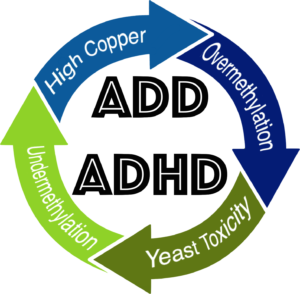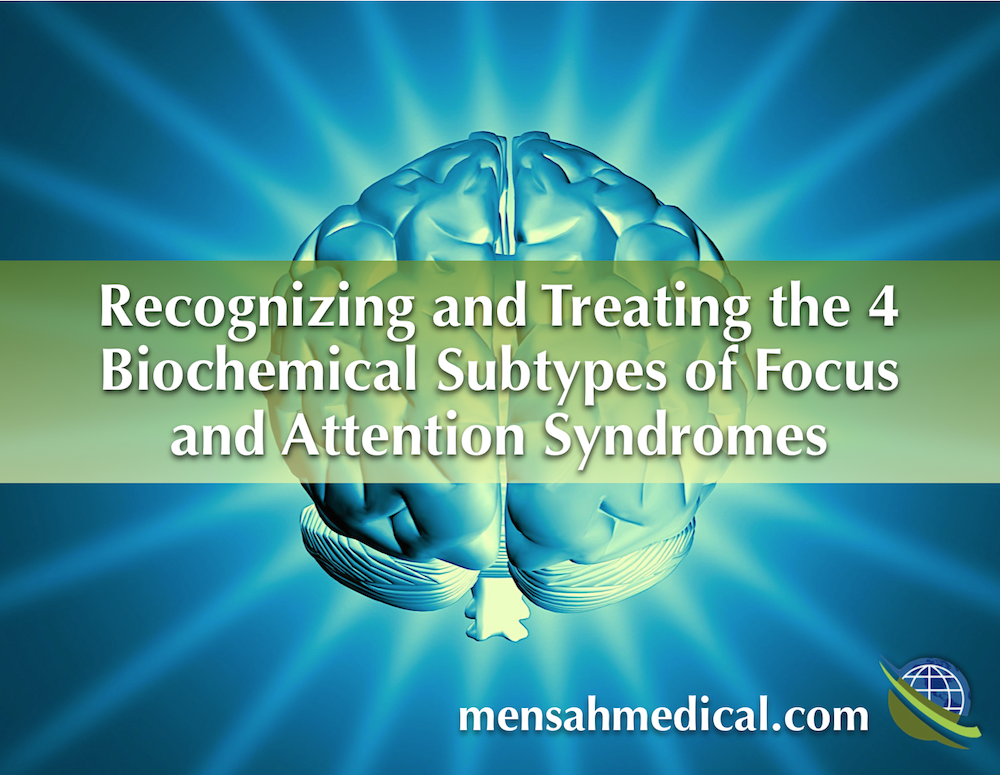Four Biochemical Subtypes of ADD/ADHD/FAS: In 2012 the CDC published their Summary Health Statistics for U.S. Children National Interview Survey. In it, they claimed an estimated 5.9 million U.S. children ages 3-17 were diagnosed with ADHD. This survey also claimed boys were three times more likely than girls to have ADHD, but the statistic that stood out to me the most, however, had to do with the general health status of the children surveyed. This CDC report said that children surveyed who had a fair or poor health status were almost seven times more likely to have a learning disability and almost four times more likely to have ADHD.
The Four Biochemical Subtypes of ADD/ADHD/FAS: Recognition and Treatment
There is a growing number in both the pediatric and adult population being diagnosed with ADD/ADHD, and we know of course that there are many social ramifications. For both parents and educators, expectations are very high. In an increasing number of cases, the system becomes too involved and can lead to the overdiagnosis of ADD/ADHD. It is a disorder we give a name to based on symptoms. This means it is a clinical diagnosis. I ask you, is the actual structure of the brain and the integration of the nerve cells at fault, either partially or wholly? What if you could test for challenges and imbalances with diagnostic testing and treat that person biochemically? Would the symptoms of ADD/ADHD improve once the biochemical balance is corrected? The answer is yes.
In the traditional world of medicine, these diagnoses are made based on clinical observations of symptoms and confirmed when patients show significant improvements in symptoms after being prescribed medications.
In our practice, we treat this condition as an epigenetic disorder. People are intrinsically and extrinsically different at different points in their lifetimes. Our genes can be influenced by environmental factors. This is called epigenetics. It’s not simply about the genes and not simply about the environment. Both are factors that contribute to biochemical imbalances in the brain which in turn will affect an entire person’s functional capacity. We see this with patients who have been diagnosed with ADD/ADHD, or what I like to call the Four Biochemical Subtypes of ADD/ADHD/FAS, or “Focus and Attention Syndromes” (FAS).
In our practice, we have found that many patients diagnosed with competent disorders like ADD/ADHD, anxiety disorders, depression, and autism have a combination of chemical imbalances such as zinc deficiencies, copper toxicities, and methylation disorders. There are known biochemical components of imbalance that are often associated with various competent disorders. We can see these patterns thanks to the pioneering work of Carl Pfeiffer MD and Ph.D., founder of Princeton’s Brain Bio Center, and over 30 years of research by William J. Walsh, Ph.D., president of the non-profit Walsh Research Institute.
We treat these Four Biochemical subtypes of ADD/ADHD/FAS with targeted nutrient therapy, designed for their specific biochemical imbalance. Some people are on ADD/ADHD medication when they come to us. Some do need medication, and respond very well to medication. We have been very successful in reducing and eliminating ADD/ADHD medication in most of our patients. In some cases, a synergistic program of nutrient therapy and medication is very beneficial. We have found that extended use of a targeted nutrient therapy protocol will reduce or eliminate the need for prescribed medications for patients with certain diagnoses. Each case of ADD/ADHD/FAS is handled on an individual basis.
The 4 biochemical subtypes associated with Focus and Attention Syndromes (FAS):

- High Copper
- Undermethylation
- Overmethylation
- Yeast Toxicity
- High Copper
The first of the four biochemical subtypes, high copper, may play a key role in Focus and Attention Syndromes (FAS). Toxic copper should be removed by natural processes in the body, and our body is generally good at getting rid of toxins. But in many children with FAS, those mechanisms break down and don’t work as efficiently as they should. Some FAS individuals can’t get rid of copper biochemically. Copper is hyperexcitable to our nervous systems. If you need coffee to get your body going in the morning, it’s likely due to the high copper content inside your cup.
When you have too much copper you get short-circuiting of processes and see inattention or hyperactive behaviors. Neural activity can be affected by a copper overload. We can run lab tests for a variety of additional elements that affect hyperactivity, focus, attention, and anxiety. Low zinc patients can’t regulate GABA, (Gamma Amino Butyric Acid), one of the calming neurotransmitters that are present in the brain. A proper copper/zinc balance can contribute to alleviating symptoms of Focus and Attention Syndromes (FAS) in most patients.
If a patient’s copper imbalance is from a biochemical inability to get rid of it, we call that metal dysmetabolism. This is one form of Focus and Attention Syndrome (FAS) we commonly treat. In metal dysmetabolism, the body stores excess copper and needs targeted nutrient supplementation to keep the copper/zinc ratio at an optimal level.
2. Undermethylation
The second of the four biochemical subtypes is undermethylation. Methylation is the ability of the body to turn on or off certain enzymes, hormones, neurotransmitters, and different chemicals by way of certain methyl groups. Methyl groups (Me) have one carbon atom bonded with three or more hydrogen atoms. These methyl groups can radically alter you, your perceptions, and your behavior. It can affect the actual type of job that you get in the future.
People with few methyl groups, also called undermethylators, are perfectionistic, persistent, and high achieving. Patients diagnosed with ADHD are predominantly in the undermethylation category.
3. Overmethylation
The third of the four biochemical subtypes is overmethylation. People with too many methyl groups, also called overmethylators, tend to be more laid back. They sit back and take it easy about things. They are also thrill seekers. Overmethylation plays an important role in the presentation of ADD symptoms. This subset of ADD can often be seen as an early presentation of bipolar disorder. We commonly see that cross-over bridge when we do biochemical testing in the overmethylated population.
4. Yeast Toxicity
The fourth and final of the biochemical subtypes is yeast toxicity. It is very important to test for yeast presence in young children with Focus and Attention Syndromes (FAS). Poor focus, attention, impulsivity, and anxiety are often related to yeast toxicity. It is a primary challenge in pediatric cases of FAS. The treatment of yeast toxicity can resolve all symptoms of ADD/ADHD/FAS. Often treatment takes three months before symptoms resolve, and treatment may need to be repeated in the course of a year to keep the yeast toxicity from reoccurring.
Final Thoughts
Patients need to understand that in Four Biochemical Subtyes of ADD/ADHD/FAS, or Focus and Attention Syndromes (FAS), we often see a combination of biochemical imbalances. It is not uncommon to have a patient with both undermethylation and yeast toxicity, for example. Patients diagnosed with ADD/ADHD need a comprehensive treatment plan to provide a true resolution to their symptoms.
Albert Mensah, MD
 As a physician in this specialized field since 2005, Dr. Mensah, board certified in integrative pediatrics by the American Association of Integrative Medicine, has treated over 3,000 patients with advanced targeted nutrient therapy. He serves on the board at Walsh Research Institute and serves as a clinical instructor for WRI’s international doctor training programs around the world. Dr. Albert Mensah received his undergraduate degree from Northwestern University (Evanston, Illinois) and his medical degree from Finch University of Health Sciences-Chicago Medical School. Dr. Mensah’s residency was in Family Medicine at Swedish Covenant Hospital (Chicago). Following residency, he completed additional fellowship training in academic development at JHS Cook County Hospital (Chicago). From 2005 to 2008, Dr. Mensah treated patients at the former Pfeiffer Treatment Center, a not-for-profit organization and outpatient clinic specializing in the treatment of biochemical imbalances including children with autism. Prior to joining Pfeiffer, Dr. Mensah was a physician at Melrose Park Clinic in Illinois. Dr. Mensah co-founded Mensah Medical in 2008 with Dr. Judith Bowman.
As a physician in this specialized field since 2005, Dr. Mensah, board certified in integrative pediatrics by the American Association of Integrative Medicine, has treated over 3,000 patients with advanced targeted nutrient therapy. He serves on the board at Walsh Research Institute and serves as a clinical instructor for WRI’s international doctor training programs around the world. Dr. Albert Mensah received his undergraduate degree from Northwestern University (Evanston, Illinois) and his medical degree from Finch University of Health Sciences-Chicago Medical School. Dr. Mensah’s residency was in Family Medicine at Swedish Covenant Hospital (Chicago). Following residency, he completed additional fellowship training in academic development at JHS Cook County Hospital (Chicago). From 2005 to 2008, Dr. Mensah treated patients at the former Pfeiffer Treatment Center, a not-for-profit organization and outpatient clinic specializing in the treatment of biochemical imbalances including children with autism. Prior to joining Pfeiffer, Dr. Mensah was a physician at Melrose Park Clinic in Illinois. Dr. Mensah co-founded Mensah Medical in 2008 with Dr. Judith Bowman.
